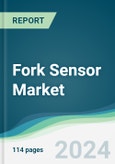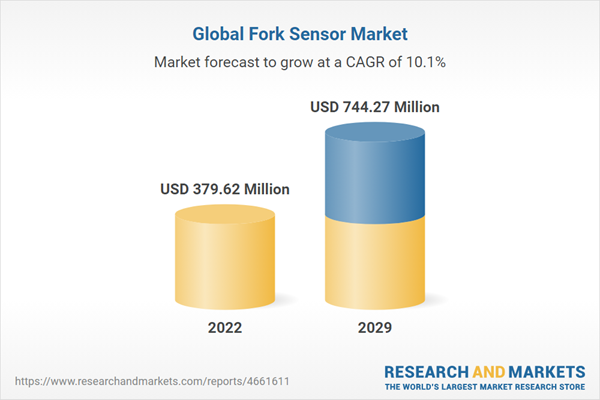The fork sensor market is expected to grow at a CAGR of 10.11% from US$379.616 million in 2022 to US$744.274 million in 2029.
The fork sensor is used to identify extremely small objects and execute counting operations in assembling, feeding, and handling applications. They are also used to keep track of the belt edge and guide. Fork sensors are the most common form of sensor used for labeling. Fork sensors have several advantages, including resilience to ambient light, ease of installation, and the ability to locate difficult label materials. Fork Sensors are commonly used in photoelectric sensing applications and are typically built in an L or U shape, with the receiver and transmitter on opposing sides of the sensing structure. These sensors help identify items going through the slot between the detecting structures by using a light source to provide a sense of direction. As the popularity of fork sensors grows, additional R&D investments are being undertaken to improve existing systems. However, the rising cost of research and development efforts in the market is one of the primary factors limiting market expansion and will continue to provide a challenge to the fork sensor market over the projection period.
MARKET DRIVERS:
Rising use of fork sensors in end-user industries.
The growing demand for fork sensors in the manufacturing and packaging industries is projected to be one of the key drivers of market growth. Companies in the fork sensors market are expected to benefit from the advent of and their increasing popularity. Fork sensors for manufacturing are predicted to rise in popularity due to their high precision and efficiency in production, as well as their increasing adoption in the food and beverage and healthcare industries. Packaging and labeling machines are used by the packaging industry to affix various sorts of labels to items in various formats, sizes, materials, and textures. The crucial procedure is label placement with high accuracy, which specifies the label's precise positioning on the product or package. Labels must be reliably detected to put labels accurately and achieve high precision, which is where fork sensors come in. The function of fork sensors is to combine the transmitter and receiver into a single device with excellent operating reliability. High-sensitivity fork sensors are distinguished by simple mounting without the requirement for alignment.
Increasing application of IoT and Smart Sensors.
The rise in popularity and desire for fork sensors as a result of the considerable spread of IoT technology, as well as the adoption of advanced smart sensors and an increase in demand from emerging nations, are all major factors driving the market forward. Furthermore, during the projection period, an increase in industry R&D efforts would provide new chances for the fork sensor market. The development in the integration of smart sensors to extract data for data analytics for smart city applications is projected to benefit the fork sensors industry. Furthermore, to fulfill the market's future needs, many important fork sensor vendors are including smart sensors in their existing sensor-based services. The growth in fork sensor inclination rate in the face of high prevalence and inclination due to the vast development of IoT innovation is projected to be a significant driver for the fork sensor market in the projected period.
Europe's fork sensor market is anticipated to grow significantly.
During the projected period, Europe is expected to hold a significant share of the fork sensors market. The expansion is mostly due to the presence of several well-established companies around the area, particularly in Germany. Germany is home to many well-known fork sensor manufacturers, including Sick AG, Leuze Electronic GmbH, and many more. Furthermore, due to constant technological developments by well-established fork sensor companies in the region, Europe is predicted to experience a higher usage of fork sensors. Furthermore, owing to the enormous expansion of IoT technology in this region and a rise in the deployment of advanced smart sensors, as well as a rise in the popularity and preference of these sensors, North America also holds a sizable market share in the fork sensor market.
Key Developments:
- Nohken announced that the VQ32 fork-level sensor series was released in September 2022, replacing the VQ22-S Sanitary model. In addition, VQ22-R and VQ32-R were placed in simultaneous sales. (VQ32-R is capable of handling even smaller applications.)
Segmentation:
By Type
- Optical Fork Sensor
- Ultrasonic Fork Sensor
- Vibrating Tuning Fork Sensor
By End-User
- Manufacturing
- Packaging and Labelling
- Others
By Geography
- North America
- USA
- Canada
- Mexico
- South America
- Brazil
- Argentina
- Others
- Europe
- Germany
- France
- UK
- Others
- Middle East and Africa
- Saudi Arabia
- UAE
- Others
- Asia Pacific
- China
- India
- Japan
- South Korea
- Taiwan
- Thailand
- Indonesia
- Others
Table of Contents
Companies Mentioned
- Baumer Electric AG
- Leuze Electronic GmBH
- Omron Corporation
- Banner Engineering Corp
- WayCon GmbH
- STMicroelectronics N.V.
- SensoPart Industriesensorik GmbH
- Pepperl+Fuchs GmbH
- SICK AG (Sick Holding GmbH)
Methodology

LOADING...
Table Information
| Report Attribute | Details |
|---|---|
| No. of Pages | 114 |
| Published | February 2024 |
| Forecast Period | 2022 - 2029 |
| Estimated Market Value ( USD | $ 379.62 Million |
| Forecasted Market Value ( USD | $ 744.27 Million |
| Compound Annual Growth Rate | 10.1% |
| Regions Covered | Global |
| No. of Companies Mentioned | 9 |









